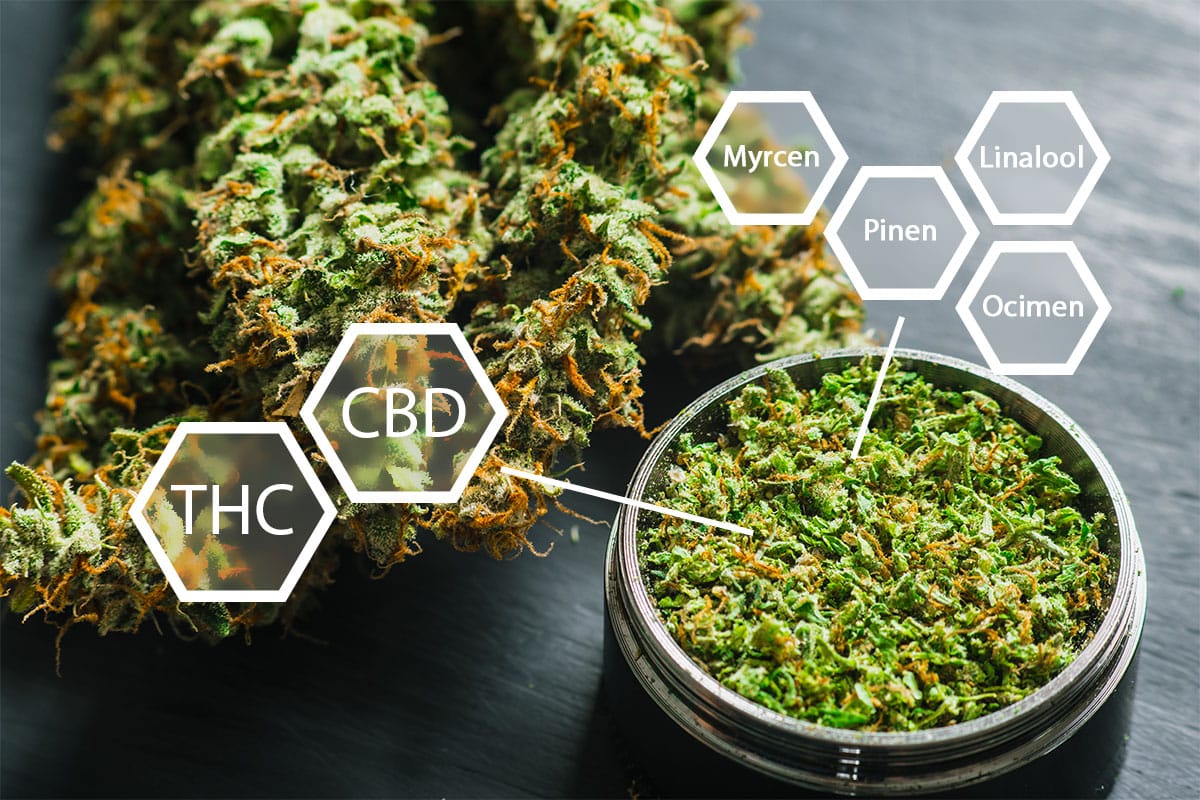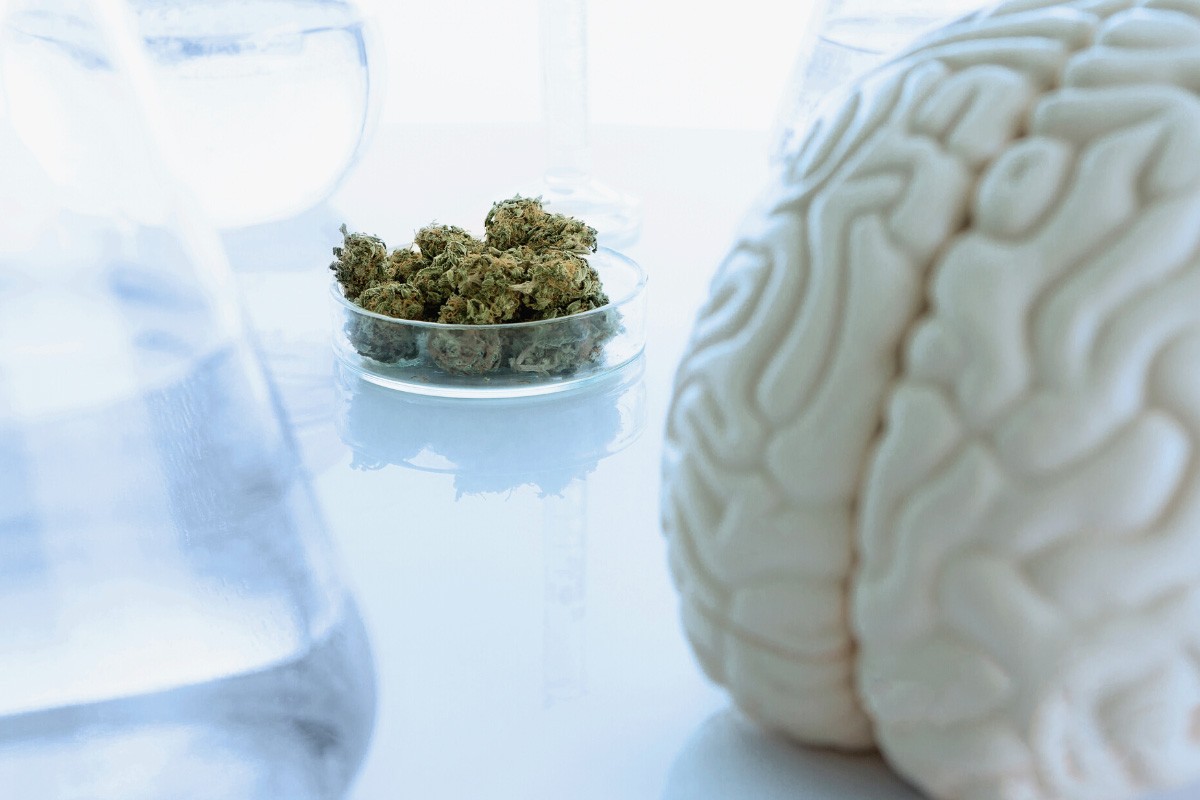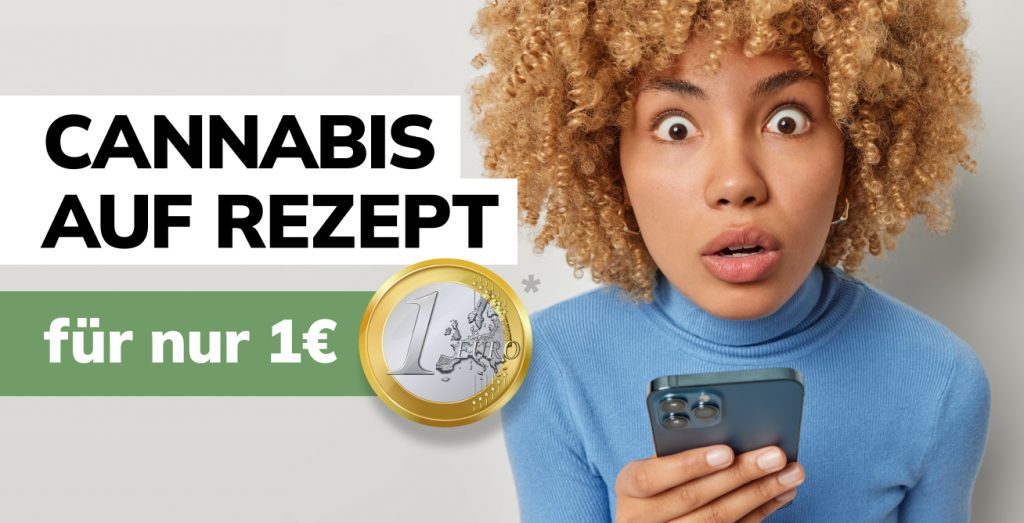There is evidence that the effect of cannabis or its Phytocannabinoids (cf. endocannabinoids) is enhanced when several components of the hemp plant are combined and taken together. With this summary, the entourage effect would be only roughly outlined, but in the following you will get a deeper insight on the influences of the various active ingredients and possible synergists in cannabis, which are suspected to trigger the entourage effect. These components are on the one hand cannabinoids like THC or CBD and on the other hand other substances like terpenes, which are responsible for the typical cannabis smell, but probably have other functions as well. Terpenes in cannabis, based on their different compositions and proportions in different cannabis strains, can impart very different odor profiles to cannabis plants. A possible efficacy advantage of taking cannabinoids and possibly terpenes in combination over taking individual components is also known as the entourage effect. We present exactly how this might work in the following sections.
However, whether the entourage effect actually exists and in which complaints or diseases it can help (in which stages) is still controversial in science. This is because the report of findings are contradictory, and thus there is still a great need for research in this area and for the analysis of much more patient data before reliable statements can be made about the effects of cannabinoids and terpenes. For a first impression, it is helpful to look at the existing scientific studies on the entourage effect, especially in relation to the Phytocannabinoids THC and CBD. However, since the research situation on the interaction between cannabinoids and terpenes is correspondingly controversial, physicians are also very cautious with these insufficiently researched findings.
Scientific studies on the entourage effect
Cannabinoids like THC & CBD and terpenes
A 2011 review published in the British Journal of Pharmacology showed that taking phyto-cannabinoids and terpenes together can be beneficial for a whole range of ailments. These include, for example, the treatment of pain, infection and inflammation, epilepsy, and anxiety [1]. The same paper on cannabinoids and terpenes also reports that concomitant use of CBD effects can mitigate THC-induced side effects such as anxiety, appetite, and fatigue.
Other authors consider the entourage effect and the possible influence of terpenes to be rather the result of subjective perceptions of recreational users and they perceive corresponding experience reports to be anecdotal [2]. However, it is true that cannabis contains so-called synergists. In the case of marijuana, this refers to ingredients in addition to cannabinoids (such as THC and CBD) that increase the effect of a drug so that the intensity of the effect is greater than when used without these additional ingredients. Typical synergists in cannabis could be secondary plant compounds such as terpenes, flavonoids, and anthocyanins. They would possibly enhance the positive effect of the cannabinoid in combination with CBD, however, further research is urgently needed here to develop evidence supporting the entourage effect in cannabis or cannabinoids such as THC and CBD.
In addition to evidence of a benefit of combined ingestion between terpenes and cannabinoids or different cannabinoid content, there are also studies that suggest at least as much efficacy of individually administered pure cannabinoids. For example, Australian researchers studied the effect of THC on cannabinoid receptors with and without the addition of (single or combined) terpenes and found no change in cannabinoid efficacy [3]. This does not necessarily mean that the entourage effect and the influence of terpenes do not exist. It is equally conceivable that the additional intake of terpenes acts at a different site, i.e. not in the receptors, but for the CB1 and CB2 signal transduction pathways or interacts with THC and CBD, respectively.
THC and CBD in combination in the entourage effect
In addition to the terpene-cannabinoid combination in the presumed entourage effect, there are also effects between the functionally antagonistic cannabinoids THC and CBD. Given the evidence for possible better efficacy when THC and CBD are combined, the question of the optimal ratio of the two cannabinoids arises. This question unfortunately cannot be answered in a blanket manner, but could depend primarily on the desired effect(s) and the individual tolerance of a person. There is no universal ideal ratio of THC and CBD, rather it must be individually adjusted and adapted to the personal situation of the patient or user.
The following two aspects have to be taken into account:
- Goal: The goals of taking it can vary widely and can range from relief of nausea or muscle pain to stress reduction and reduction of anxiety.
- Side effects: Each ingredient can cause adverse effects, which can vary greatly between substances, but also between users. Possible side effects of psychoactive THC include dry mouth, fatigue, anxiety, slowing of reaction time, and impairment in short-term memory. In contrast, CBD use would be more likely to be associated with gastrointestinal problems and resulting changes in body weight. However, for some gastrointestinal problems, administering CBD may also assist in treatment, as studies on CBD oil and Crohn’s disease suggest, so a blanket statement of side effects with CBD and/or THC is not possible due to the divergent research situations.
Different variants and combinations can result from these requirements, but they can still have different effects from person to person. Often only careful approaching in dosage and composition remains to find out the ideal combination in the use of CBD. For preparations containing THC, with which a possible entourage effect could take place, always consider the opinion and instruction of the attending physician with whom the cannabis therapy is carried out. Independent changes of the dose in a therapy with medical cannabis or even the change of the active ingredient composition without medical consultation could endanger the success of the therapy. Even when experimenting with cannabidiol (CBD) yourself, observe the legal regulations for taking CBD and always start with a low dosage of CBD, which you can gradually increase if necessary. You can also try different dosage forms for the effect of CBD, because cannabidiol is offered, among other preparations, as CBD oil, in the form of capsules or even for vaporization.
Differences in CBD Products and Entourage Effect
Full spectrum, broad spectrum and CBD-isolates
Which ingredients are contained in a cannabis product, i.e. how many different cannabinoids and terpenes in which ratio are balanced, and whether these could lead to an entourage effect, can already be deduced to a certain degree from the classification. Basically, there are three types of cannabis oils: Full spectrum, broad spectrum and isolates.
Entourage effect in full spectrum products
Full spectrum products contain all the ingredients of the cannabis plant. This includes all cannabinoids (such as CBD and THC), but also terpenes, flavonoids and other secondary plant compounds. The THC content can still be possibly 0.2% in mainly CBD-containing products. An entourage effect could therefore also be observed in CBD products. Whether and how this turns out, is individually very different. The composition of the individual ingredients can also vary considerably depending on the hemp variety. Given the large differences between the individual plant strains, the respective growth conditions and the degree of maturity at harvest, full-spectrum products are difficult to compare with each other in terms of their effect (and also their taste).
Entourage effect in CBD broad spectrum products
Products in which the psychoactive THC has been almost completely removed (THC content
Entourage effect in CBD isolates
In addition, there are pure CBD products that contain only cannabidiol (CBD) and no terpenes. These so-called isolates are absolutely free of THC, but also do without possible positive side effects from other secondary plant compounds. Therefore, no entourage effect would be observed with CBD isolates. Since there are also no terpenes in these products, they could be very mild in taste and thus could be especially good for first-time users.








